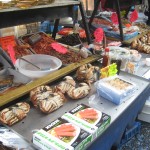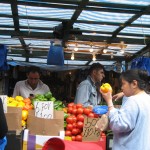September 12th, 2009 · No Comments
This post is in response to the excerpt that Professor Qualls shared with us from his upcoming book. In this introductory chapter, he raises several key points which translate into our discussions about race, ethnicity and identification in London.
First, he uses the term “identification” rather than “identity.” I feel that this terminology is much more appropriate – even somehow liberating – in that it implies a choice and agency whereas the term “identity” connotes a sense of inescapability.
Second, Professor Qualls claims that “[a]s with memory, urban identifications are both internally and externally manufactured.” This can be seen in London, especially. The language barrier and cultural difference that immigrants inevitably experience coming to a foreign country certainly play a role in this “process of identification.” It is reasonable that immigrant communities would identify much more readily with a community that theirs their cultural, religious and linguistic traditions. It is the external forces, then, that cause problems.
Indeed, Qualls mentions that “[i]dentification can be either categorical or relational.” When outsiders (external forces) categorize or imagine relationships between immigrant groups where none might exist at all*, they are essentially “othering” those populations, isolating them from the rest of society and making it virtually impossible for any foreigner to feel comfortable here, let alone the possibility of “assimilation” – which I think is a completely ethnocentric idea to begin with.
It is not the responsibility of immigrant populations to adapt to the country in which they are residing, so long as they learn to respect that country. But this is a two-way-street. Locals must also learn to respect those immigrant populations which whom they share their space.
Particularly in London, these unique immigrant communities are what makes the city uniquely “London.” Or, to, yet again, quote Qualls: “maintaining past traditions was essential to the stability and happiness of the population, which in turn would reflect well on the central regime.”
*Some of you may remember the story Andrew Fitzgerald, Andrew Barron and I shared with you at the beginning of the course: At our market in Elephant and Castle, we witnessed an altercation between a darker-skinned customer and a white, cockney fruit and veg vendor. The vendor called the customer a “Paki” and obviously had no legitimate basis for determining this man’s ethnicity. Just because the customer had darker skin, the cockney vendor “related” him to a Pakistani. This is a dangerous comparison which only serves to fuel racism.
Tags: Anya
September 7th, 2009 · 4 Comments
Over my one-pound-fifty take-out lunch that I brought back to the garden, Megan and I discussed last week’s blog topic: identity and immigration. “I just have no idea where I’m going to take this,” I said. “We’ve done so much reading about this already, I just feel like I have nothing new to say.” Megan agreed, saying that she felt as though she had done all the research, knew all the background information, and was just struggling to “find a conclusion.” I think we both really had valid points here.
It is impossible to form any sort of thesis about identity and immigration in London because of the essence of London. It is, according to one of our Guardian readings on race, “a city with immigrants” rather than “a city of immigrants,” like New York. London is definied by its ever-shifting immigrant populations. If one were to establish some sort of grasp on what immigration means to London today, and what London means to immigrants today, it would shift within a matter of years and become obsolete. Immigration is part of what makes London London, and therefore, there is nothing new to say about it because it has always been this way, and will continue to be.
Perhaps this blog is too short, perhaps some of you will think it was ill-structured, poorly thought-out or had no new ideas to introduce to the reader. Well, you may be right. However, over-analyzing immigrant populations – identifying where the Afro-Caribbean communites or the Polish communities or the Jewish, Indian, Bangladeshi or Pakistani communities are located – only serves to further isolate these populations from one another and from the rest of British culture. We’ve discussed the topic to death. What we need to do now is look at the issue from a new vantage point, or even better, from no vantage point at all. If we accept immigrants as Londoners, and cease to discuss these populations as separate entities, then the possibility of a new London would be possible.
Tags: Anya
September 5th, 2009 · 1 Comment
A great perk about studying abroad in England is that you’re doing just that: studying. Everything we do is a learning opportunity. We constantly are taking note of the interactions between people, what groups of people are present in what area, and conversely what groups of people are absent from what areas. As much as I love this constant state of observation, I can’t help but wonder if sometimes I’m reading too much into situations. About three minutes ago when I started this blog, I planned to write on how different groups of people are treated differently throughout London. I still believe this is true. But in those three minutes, a wonderful thing happened. Space Jam came on! If you don’t remember, the movie involves Michael Jordan and Bugs Bunny saving the world from evil aliens. Talk about quality entertainment! Two children from London picked out the flick to watch before their bedtime and, being the mature people that we are, four of my fellow students and I are kindly decided to keep them company (while reciting our favorite lines right along with them). The children can’t be more than nine years old. We are all a little more than double their ages. Yet here we are all sitting around a television enjoying a Saturday night together. As this happens, I’m wondering: just how differently are separate groups of people in London? In its first couple scenes, Space Jam has told us that forced control over others is wrong, that stealing talents and goods from others is wrong, that everyone has something to learn from others, and that everyone has something to teach others- not too shabby for a movie that stars a basketball player and an animated rabbit. On our visit to a gurdwara, we were told that those who followed Sikhism believed in lifelong communal learning as well. I in no way mean to belittle Sikhism to the level of Space Jam. I do believe though that the people sitting in the lounge with me are listening to similar messages as those that are delivered in gurdwaras. With such similarities being apparent in mainstream culture and arguably a minority religious belief in London, the separation between these groups is sadly easy to recognize. This may seem paradoxical but I believe it makes sense. Clearly, the mainstream culture and minority cultures claim to believe in similar ideals: communal learning. Yet the London community is separated (making such learning difficult) based off of ethnicity, race, and class. How frustrating! I could understand if these groups’ core values or ideals were so conflicting that problems arose and, therefore, separation made a bit more sense. But that doesn’t seem to be the case. Some sort of disconnect is present. A misunderstanding between cultures? A hypocrisy in one or both? What accounts for this separation?
There doesn’t seem to be easy answer. Our class discussions have tended to point the finger at the majority culture and for the most point I’ve supported that sentiment. But I don’t know if the answer is really that simple; that is, I don’t think that the mainstream culture holds 100% of the responsibility for the separation that exists between cultures. But Space Jam reminds us that we can all get along in the end if we just communicate with one another instead of ignoring how much we have in common and highlighting our differences. That’s not to say that our differences should be completely erased. The Sikhs have a beautifully unique lifestyle that, in my opinion, shouldn’t be ‘mainstreamed’. But to have a gurdwara all the way in Southall rather than have a felt presence in London, to have Brick Lane be a predominantly Bengali community with few other places in the city where such communities exist, basically to have a separated society is, to me, exactly opposite of what all of these communities teach. Maybe Michael and Bugs need to make another movie for this lesson to be learned. I know I would gladly spend another Saturday night learning from them. But my hope is that the lesson isn’t just taught. Clearly, that is already happening. The hope is that the lesson starts being learned and applied. Maybe I’m reading too much into Space Jam’s influence on London culture. But as a student who is always observing and studying what’s going on in my surroundings, I don’t entirely think that’s the case.
Tags: Audrey
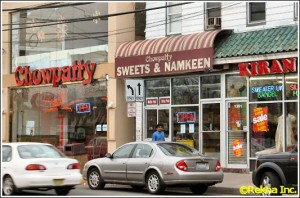
"Little India"
I haven’t missed home much during the past two weeks. We have been so busy with tours and museums and plays that I simply haven’t had time to be homesick–until yesterday and today. London’s East End and Southall reminded me so much of my hometown that I couldn’t help but long for good old Iselin, a place I took for granted before I came to college.
The town I’m from is extremely diverse and has a large South Asian population. For example, the top languages spoken in my high school (as of 2008) are English, Gujarati, Spanish, Urdu, Panjabi, Hindi, and Tagalog. Oak Tree Road and Green Street, the two main roads running through Edison and Iselin, NJ are lined with sari shops, curry houses, cash and carries, and more. The annual India Day Parade is the biggest event around and Bollywood stars are commonplace on billboards.
Growing up, I never really realized or appreciated the cultural diversity I experienced on an everyday basis. Even though the Indian/Bengali population has left the greatest mark on my area, there are numerous people of other backgrounds who reside in my area. The example I often use to make this point is if you come to visit me, I can find ANY kind of restaurant you can think of (Indian, Japanese, Chinese, Thai, Greek, Mexican, Spanish, Kosher, Portuguese, Mongolian, Polish, and Ethiopian are the ones I can list off the top of my head). Before coming to Dickinson and Carlisle, I never really thought about how much of the rest of the United States is, in fact, not like this at all.
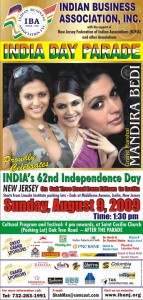
Advertisement for the India Day Parade on Oak Tree Rd.
Living in such a culturally diverse place has not always led to positive experiences. As we’ve seen and heard of in London, there is a lot of ethnic tension in my area due the sudden boom of immigrants that started in the 1990s. I’ve heard my friend’s parents refer to their neighbors as the “terrorists down the street,” and “dot-heads,” “deets,” and “hajis,” are only a few of the pejorative terms heard on a regular basis. I remember one of the blog posts mentioned an altercation between a white man and a South Asian man in a market, which reminded me of a time I was in the Target by my house and a white man shouted at the Indian man in front of him in line to, “go take a fucking shower and come back when you know some fucking English.” Another friend’s mother claimed that the Indians “stole” our Christmas light and use them for their holidays, disregarding the fact that Diwali is the Festival of Lights and electric lights are common decorations for purposes other than Christmas. I’ve even lost one friend within the past year because I refused to put up with his increasingly racist comments any longer.
I hope that this relatively new immigrant group will in time become more accepted in both American and British society. However, I might be rather pessimistic or cynical, as I can’t help but think that a new population will replace the lowest rung on the social ladder once this is allowed to move up. What I know for sure, though, is that all I can do is my part to try to fight intolerance and racism so that people might realize all of the wonderful things various cultures have to offer.
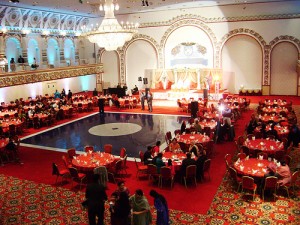
Royal Albert's Palace--An Indian catering hall where my friend had her Sweet 16
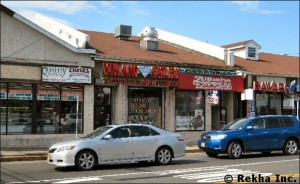
Oak Tree Road
Tags: Sarah
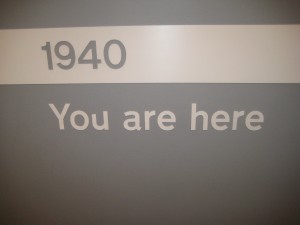
As I entered The Cabinet War Rooms and Churchill Museum I noticed a sign that appropriately read “1940 – You are here.” The War Rooms especially had the effect of transporting me back through the decades and directly into the blitz years. I let myself become immersed in the time period, trying to experience the War Rooms as they would have been experienced during the blitz. Walking through the halls and listening to the recordings of secretaries furiously punching at typewriters, phones ringing, air raid sirens screaming and the distant, guttural peal of bombs – like some Gregorian chant – , I felt as though I truly was there.
Living quarters were by no means spacious or luxurious. Winston Churchill and his staff lived in small bedrooms with small twin beds – some cots, even – and small furniture, and they cooked in a small kitchen. The fact that the Prime Minister lived and worked in a somewhat average space – though his accommodations were by no means completely Spartan – impressed me. It reminded me of how The Queen Mother rejoiced at the bombing of Buckingham palace and felt that she could now more closely connect and identify with her subjects. Churchill, in this way, was living in a similar fashion as those who elected him.
The War Rooms themselves were built underground. It consisted of several levels including a sub-basement or crawl space area. The Rooms were protected by steel-reinforced concrete up to three metres thick, depending on the area. The halls seemed labyrinthine – I’m not sure if the Rooms were laid out this way throughout the blitz, or if they were re-arranged when the museum was opened, though many of the rooms were left just as they were.
The Churchill museum was equally as interesting, though it brought up current issues as well as those from the past. One section in particular focused on Churchill’s sentiments towards the Indians. In rather “politically correct” and certainly “British” words, a placard mentioned that Churchill took a social Darwinist approach with his policies towards India, claiming that if Great Britain had not intervened, the religious factions in the country would surely turn against one another in a barbaric warfare. I was not particularly surprised by this, unfortunately, considering the problems dealing with race and ethnicity seen so frequently throughout the latter half of the 20th century. In fact, perhaps those later problems were actually rooted within the racist history of previous British policy.
Overall, the museum was very informative and interesting, especially the Cabinet War Rooms section. The ability of the exhibit to situate the visitor in the heat of the blitz renders this museum truly successful in meeting the goal that all museums should strive to achieve;reaching – and truly affecting – its audience.
Tags: Anya · Museums
We took the Central Line from Goodge Station and switched onto the Waterloo line to Elephant and Castle at Charing Cross. As we moved farther down the line, we noticed that the number of business suits diminished and were replaced by more eccentric garb and hairstyles. After getting off at Elephant and Castle, we started to head in the right direction (towards Walworth Street) only to be re-routed (due to a “fatal accident” involving a bus) down a rather sketchy alleyway, only to make one giant loop and end up where we started. We wandered around, getting even more lost, and after consulting A-Zed, we finally got our bearings and headed down Walworth Street towards the East Street Market. Once there, we were bombarded with a rush of people, wares, sounds and smells. Reggaeton blasted from a CD and cassette tape booth, women in burkas sat under a tent draped with pashmina scarves and the aroma of bangers and burgers hung heavily in the air over the scene. Middle-Eastern and African vendors sold seafood and exotic fruits and vegetables arranged in wooden crates, and women loaded the produce into their bags, bartering with the vendors. There were booths selling watches, clothing (suits, dress shirts, slacks and lingerie), shoes, belts, toys, Christian books and movies, hats, sunglasses, jewelry, bags, scarves, cell phone accessories, linens and toiletry and cleaning products. But more interesting than the wares being sold was observing the interactions between those selling and buying. Vendors, for the most part, kept to themselves and did not call out to passersby. Some left their booths completely vacant and vulnerable to theft. One vendor in particular caught our attention. One of the few white British fruit vendors angrily accosted a potential buyer. As we were passing, we heard the vendor say to the man, “Speaking bloody f***ing English, you f***ing Bangladeshi.” The man walked away from the booth, and responded in very clear English, “English c**t.” We were shocked by witnessing obvious racial tension for the first time. It has become such a common scene in London to see people of all ethnicities sharing common spaces and interacting amicably with one another, and the altercation took us by surprise. Finally, we took the 176 to Tottenham Court Road and headed back home. While tensions do obviously exist in England, places such as East Street Market represent, for the most part, the harmony and co-existence between cultures which necessarily occurs every day in London.
Tags: Andrew F · Andrew R · Anya · Markets








